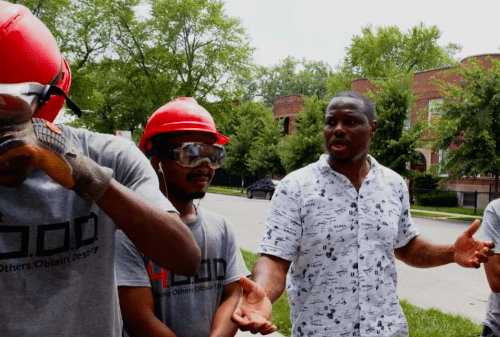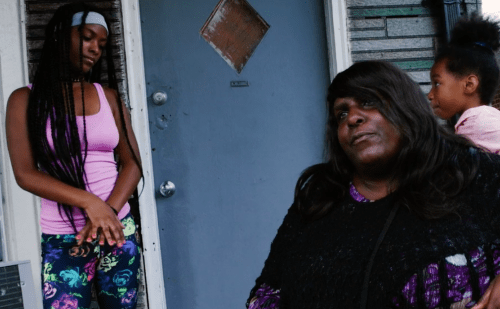Liberalism’s Fear Of Shelby Steele

We saw last week how Big Tech — Twitter and Facebook — tried to control the political Narrative by making it impossible, or at least difficult, to spread the New York Post‘s scoop about Hunter Biden’s hard drive. Notice that the Biden campaign has not denied that what’s reportedly on that hard drive is true. The media have been running interference for Team Biden by focusing on how the Post obtained that information.
Here’s another jaw-dropping move by the media controllers to restrict the Narrative. You might have heard that Amazon has refused to add a new documentary, What Killed Michael Brown?, to its streaming service. The documentary was written by and stars the conservative black scholar Shelby Steele, and was directed by his son Eli Steele. In it, the elder Steele examines the shooting death of Michael Brown in Ferguson a few years back, and its place in the larger story of race in America.
Here’s what Amazon told Eli Steele in rejecting the film for inclusion on its streaming service:

Your title doesn’t meet Prime Video’s content quality expectations. Why not? What could possibly be so offensive about this movie that Amazon Prime, which streams some real junk, won’t let it onto the platform? I e-mailed the film’s producers and asked for a press screener (which I encourage all media to do by clicking here).
After 15 minutes, it was perfectly obvious why Amazon wouldn’t let this movie show: they do not want any criticism of the progressive narrative about Michael Brown, and about race in America in general. There is only one acceptable narrative — and black men like Shelby and Eli Steele who challenge it must be silenced.
It’s hard to overstate the power of What Killed Michael Brown? It’s not a bombastic polemic, in the style of Michael Moore. Eli Steele is a cool, careful filmmaker. Its power is in its understatedness, its reasonableness — and, of course, in the truth bombs that Shelby Steele drops throughout the whole thing. This film is so dangerous that Amazon doesn’t want people to see it. Why is Amazon so afraid of a gentle 74-year-old black professor?
Here’s why.
Notice the title — not who killed Michael Brown, but what. We know who killed him: Ferguson police officer Darren Wilson, who was not indicted for the shooting. Shelby Steele wants to know what forces brought Michael Brown to that fateful encounter with the white officer. In exploring this question, Steele shines a piercing light on the way our media, politicians, and institutions construct the narrative about race in America.
He observes in the film’s opening minutes that in 2014, the year Michael Brown died in Ferguson, over 700 black men were shot and killed in Chicago, by other black men. Nobody in Black Lives Matter cared much about those black lives, nor did the national media. It’s only when a black life is taken by a white police officer that they care. Late in the movie, Steele observes that more and more black children are dying from drive-by shootings in their neighborhoods. Activists barely noticed. Observes Steele, “There was no power for blacks, or innocence for whites, to be had from these innocent deaths.”
What explains this? “We human beings never use race except as a means to power,” Steele says. His thesis is that “racism” did not kill Michael Brown, but rather that Michael Brown became the sort of thuggish young man who threw his life away because of cultural forces of disintegration emerging from 1960s liberalism — and that is something we cannot bring ourselves to face.
Steele reflects on his 1960s past as a self-described “black militant” working in LBJ’s War on Poverty. He worked for three years with the black poor in East St. Louis. Young Steele was optimistic then about what the government could do for the black poor who had been held back for so long by racism. What he learned was that the antipoverty programs were not really about advancing black people in the name of social justice. Rather, he says, “Taking advantage of white guilt was the focus of justice.”
Steele explains the concept of “poetic truth.” It’s not the objective facts about a person or an event, but what others believe those facts to mean. Poetic truth is a synonym for “myth” — a story that may or may not have basis in fact, but which we use to explain what the world means, who we are, and how we are supposed to react. With poetic truth, says Steele, “you don’t think so much as step into that meaning.”
Poetic truth always distorts objective truth, and can be used to gain power. That, says Steele, is exactly how black activists and their allies have used and abused the Michael Brown narrative. He explains what is well established truth (according to the US Department of Justice’s investigation): that Michael Brown died after attacking Officer Wilson and trying to take his gun. Michael Brown was in no way an innocent victim of police brutality. But, says Steele, “poetic truth set the stage for a power grab.”
I had forgotten the role that Obama Attorney General Eric Holder played in this drama. Steele is quite harsh on him. The DOJ under Holder proved that the Michael Brown victim narrative was entirely false — but as Steele shows, Holder inserted himself into the Ferguson situation in a racialized, politicized way, and turned the town in which a bully was shot trying to assault a cop into a symbol of America’s 400 years of racist oppression. Says Steele, “Holder made Ferguson pay the price for a racist murder that was neither racist nor a murder.”
If Michael Brown is a victim, then he is the victim not of a racist cop, but of the toxic culture of 1960s liberalism, which, in Steele’s words, “focused far more on assuaging white guilt than on black development.” Steele talks about how federal social engineers destroyed working-class black homes, and the equity that was in them, to build massive housing projects that dispossessed and ghettoized black people in lawless hives. Moreover, this kind of liberalism conveyed to blacks that they didn’t have to take responsibility for their own lives and fate, but rather had to depend on how much they could extract from guilty white people. “The poetic truth of black victimization became their identity,” he says. Liberalism consigned blacks to “invisibilization,” to “permanent victimhood.”
“The faithlessness in black authority is what gave us the world that Michael Brown grew up in,” Steele says.
And further: “Modern liberalism does not like human complexity in its victims. It wants the lines of responsibility to be clear and simple, and always to point to the white world.” Liberalism wants blacks to give up before even trying, by convincing them that no matter how hard they work, they can never get ahead. Though Steele condemns the police killing of George Floyd as a “murder,” he casts a gimlet eye on the violent protests that followed, saying that Floyd’s murder was “less a tragedy and more an opportunity” for cynics seeking to advance their grip on power.
Steele profiles contemporary black neighborhood activists, including a pastor on Chicago’s poor and violent South Side, who are trying to return a sense of agency and responsibility to communities decimated by the moral collapse of institutions of black authority: the family, the school, and the community. Here are two of them you meet in the movie:


In these people, Steele sees a contemporary version of his late father, a black man raised in deep poverty and segregation, with only a third grade education, but who raised himself and his family up by virtue of his self-discipline and hard work. He calls the Black Lives Matter movement a “bad faith movement” that wants to dismantle America, by contrast to the Civil Rights Movement, which wanted blacks to be part of America.
Why is that message so threatening to Amazon? Maybe Shelby Steele has it wrong. Maybe he’s blind to things that others see. Fine — release the movie and let people make up their own minds. Stop this liberal paternalism that doesn’t trust people to think for themselves. The fact is, a lot of people, including black people, will watch What Killed Michael Brown? and hear an authentic American voice, the voice of common sense and bedrock American values. It won’t be good for the Victim Industrial Complex. Hence Amazon’s desire to control the narrative.
In 1989, the black critic Stanley Crouch — who died last month — published a searing essay in The Village Voice about Spike Lee and his new film Do The Right Thing. He denounced the film as “Afro-fascist chic.” Excerpt:
One must always face the razor’s edge of the fact that race as it applies to American identity has a complex relationship to the grace, grime, and gore of democracy, and that an essential aspect of democracy, of a free society’s exchange of ideas, is that we will inevitably be inspired, dismayed, and disgusted by the good, mediocre, and insipid ideas that freedom allows. The burden of democracy is that you will not only get a Thurgood Marshall but an Alton Maddox, a Martin Luther King and an Al Sharpton — the brilliant, the hysteric, the hustling. And in terms of film opening up to more and more black people, there is no doubt that most will follow trends and appeal to the spiritual peanut galleries of society as long as there is money to be made, while a few will say something of importance, not only to American society but to the contemporary world. Few in this country have ever wanted to be artists, have wished to challenge or equal the best on a national and international basis. Most want no more than a good job and — in our time of the rock-and-roll elevation of the brutish, the superficial, and the adolescent — pop stardom. Those who believe that such American tendencies will fall before the revelations of the sword of the Negro soul are naïve.
That naïveté, like an intellectual jack-in-the-box bumpkin, periodically popped up through the Black Filmmaker Foundation’s ceremonies. There was much talk of “controlling our images,” a term suggestive of the worst political aspects of black nationalism, one far more dangerous if taken in certain directions than, say, expanding our images. Such “control” without attendant intelligence and moral courage of the sort we saw so little of during the Brawley farce or rarely hear when Louis Farrakhan is discussed, will make little difference, since the problems Afro-Americans presently face extend far beyond the unarguable persistence of a declining racism. Intellectual cowardice, opportunism, and the itch for riches by almost any means necessary define the demons within the black community. The demons are presently symbolized by those black college teachers so intimidated by career threats that they don’t protest students bringing Louis Farrakhan on campus, by men like Vernon Mason who sold out a good reputation in a cynical bid for political power by pimping real victims of racism in order to smoke-screen Tawana Brawley’s lies, by the crack dealers who have wrought unprecedented horrors, and by Afro-fascist race-baiters like Public Enemy who perform on the soundtrack to Do the Right Thing.
In more than a few ways, Do the Right Thing fits the description Susan Sontag gave fascism in her discussion of Leni Riefenstahl, “Fascinating Fascism.” Sontag says fascist aesthetics “endorse two seemingly opposite states, egomania and servitude. The relations of domination and enslavement take the form of a characteristic pageantry: the massing of groups of people; the turning of people into things; the multiplication or replication of things; and the grouping of people/things around an all-powerful, hypnotic leader-figure or force.”
In Do the Right Thing, the egomania and the servitude, the massing of people into things, and the irresistible force are all part of blackness. That blackness has the same purpose Sontag recognized in the work of Riefenstahl: it exists to overcome “the dissolution of alienation in ecstatic feelings of community.” Lee’s vision of blackness connects to what Sontag realized was “a romantic ideal… expressed in such diverse modes of cultural dissidence and propaganda for new forms of community as the youth/rock culture, primal therapy, anti-psychiatry, Third World camp following, and belief in the occult.”
Notice the difference Crouch draws between controlling the images, and expanding them. That’s precisely what’s going on here with Amazon’s actions towards the Steeles’ film. And, the poetic truth that Shelby Steele so powerfully illuminates and dismantles in What Killed Michael Brown? is a baldfaced lie about race and America that promises to deliver its believers from alienation — both its black believers and its white believers (who are so desperate for absolution from racial guilt that they will accept anything). As I write in Live Not By Lies:
A totalitarian state is one that aspires to nothing less than defining and controlling reality. Truth is whatever the rulers decide it is. As Arendt has written, wherever totalitarianism has ruled, “[I]t has begun to destroy the essence of man.”
When Shelby Steele, in this extraordinarily important, even urgent film, exposes the lies of Michael Brown’s death, and of the left-wing race narrative, and concludes that “liberalism wants your very soul” — this is exactly what he is talking about. No wonder Amazon, as one of this culture’s controllers, will not permit any challenge to its monopoly on reality. Shelby and Eli Steele are two of the bravest men in America, and I mean that.
UPDATE: A reader points out that you can buy a DVD or Blu-ray version of What Killed Michael Brown? here. I hope you will. Not only will you support these filmmakers and their worthy project, but you will own a movie that you can show to your kids and to your friends, and talk about these issues. Shelby and Eli Steele put a lot on the line to tell this story; we should stand with them by buying their work and telling others about it. This really is a first-rate documentary.
UPDATE.2: Great news from Eli Steele:
Dear all,
Good news to report. Yes, the film has done extremely well since its launch last Friday but that is not the good news for today.
Amazon reached out to me late this afternoon and we had a positive exchange of emails — I prefer emails to the phone due to my deafness. Apparently, we had an uninvited third party that interfered on my behalf, unbeknownst to me, and that caused confusion. So it was good to communicate with them directly; I listened to their side and they listened to mine.
They acknowledged what happened and said they would work to improve and prevent incidences like this one from happening again.
Given today’s volatile culture war, I believe this was a positive step. They will have this experience on their minds going forward and one hopes they will improve their policies so that all American perspectives are included. They certainly did not have to reach out, but they did and that gesture is meaningful.
I do want to thank the writers at Wall Street Journal, Fox News, National Review, and many other places for writing about this. Without this publicity, we likely would never have reached this resolution. Thank you.
So, I am very happy that I can finally announce officially that our very well received documentary, “What Killed Michael Brown?”, is now on the Amazon platform!
The film will continue to play on Vimeo as well.
Hopefully, our experience with Amazon can provide a benchmark and my father and I can now focus on the most important thing to us: the film’s message.
And when you do watch it on Amazon, please be kind enough to leave us a review. Helps us shoot up the ratings. 🙂
Subscribe for as little as $5/mo to start commenting on Rod’s blog.